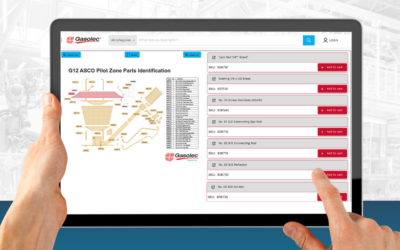It’s a given – your customer’s machine will eventually need routine maintenance or even replacement parts. Their entire operation might be forced to shut down while waiting for vital equipment replacement parts to be purchased, delivered, and installed, so it’s critical that replacement parts are easy to find and order. Even worse, if they don’t have the exactly correct part information, the wrong part might be ordered and delivered to the customer, further delaying the repair process and creating customer frustration (directed likely at you). Unfortunately, the process isn’t always ideal, especially given that they are likely trying to order replacement parts on-site at the machine itself from a mobile device.
Here are three ways to be there for your customer when they need you most:
1. Help them figure out what part they need
Sometimes a customer will know exactly which replacement part they need, especially if they are familiar with the machinery or have prior experience performing routine maintenance. However, it’s far more likely that the customer may not even know what’s wrong and will need some troubleshooting assistance to discover which specific part that is causing the issue.
Easy-to-find troubleshooting videos and access to digital product manuals on your site will help customers figure out which part(s) they need, and schematic drawings of assemblies and/or subassemblies will help them find the specific part information.
2. Allow them to reorder even if they’re missing important information (serial no, model number, etc.)
It is common that a customer may be missing key part information, especially in aftermarket situations or when the buyer has purchased the equipment second-hand and may not have received the original serial or model number information or instruction manuals.
A good, robust digital parts ordering solution will offer alternative methods of finding replacement parts other than serial or model numbers. Clear, navigatable schematics or interactive parts diagrams can be very helpful in this situation. A real-time, digital diagram or schematic is essential as parts change, are deprecated, or recalled. Legacy PDFs of product diagrams do not suffice for today’s customer — you must have the real-time data associated with the parts and products.
3. Make the part easy to locate
The success or failure of any e-commerce website lies in how easily buyers can locate what they need. It is imperative to understand your customer’s needs at each stage of their purchasing path in order to reduce lost sales by frustrating them to the point that they shop elsewhere.
To help your buyers easily locate your product, a clear and easy-to-use site navigation, well organized categories, and a high-functioning search bar will all help to create a better online shopping experience, improve on-site engagement, and ultimately, increase sales.
Once a buyer has found the part they think they need, high resolution images and detailed product information are key to help confirm for the buyer that they have indeed found the correct part. Adding options to zoom in and enlarge photos, especially if offering parts diagrams or schematics, removes any uncertainty about what the parts actually look like. And again, remember that most buyers these days are ordering using mobile devices, so your site needs to offer these solutions optimized for the smaller screen.
Helping buyers resolve these 3 common issues when trying to find and order equipment replacement parts on your site will set you apart from your competitors, increase sales, and build customer loyalty.
If your products require replacement parts and a robust online catalog could help your bottom line, please share a few details and we will be in touch.
Feature Posts
Introducing InteractiveSchematics: Streamline Your Parts Management
Are you still managing parts sales with outdated PDFs, obsolete parts lists, or elusive paper product manuals? It’s time for a transformation. Envalo is proud to introduce InteractiveSchematics, a cutting-edge solution designed to simplify parts management and elevate...
Adding a Direct-to-Consumer Model Does Not Mean Leaving Your Dealers Behind
As a manufacturer, you’re faced with responding to the evolution of your end customer. Technology continues to change the playing field. Before the Internet, manufacturers relied on sales reps, dealers, and distributors to build awareness and get their products into the hands of their customers.
Post-Purchase Engagement for Industrial Manufacturers: Build Loyalty and Increase Sales
Industrial systems are often large capital investments that last years. Upselling or reselling to the same customer year after year isn’t an option. With near-term sales goals on the horizon, your focus is likely on generating new leads and sales.




